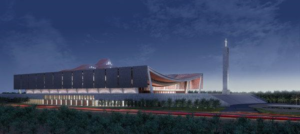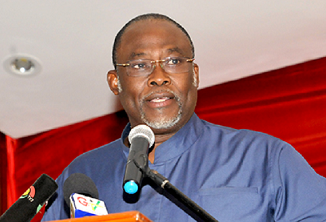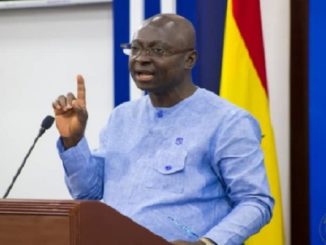By Dr. Okeke-Agulu (@Chikaokekeagulu)
 (A rendering of the National Cathedral of Ghana, designed by the Ghanaian-British architect David Adjaye. Credit Adjaye Associates)
(A rendering of the National Cathedral of Ghana, designed by the Ghanaian-British architect David Adjaye. Credit Adjaye Associates)
Last month, the president of Ghana, Nana Akufo-Addo, unveiled the design for a national cathedral that the government will build in Accra. This is a huge deal. It signals that the country is poised to consolidate the gains of decades of democracy. And the new interdenominational Christian cathedral will inspire ambitious civic architecture projects across the continent that harness the talents of Africa’s emerging artists.
Not everyone is cheering, though. Some West Africans have complained that the mixing of church and state is ill advised. They argue that it’s a worrisome case of official partisanship in a part of the world rived by religious conflicts. Others say the money for the project should have instead been invested in schools, hospitals and infrastructure — stuff that, according to them, Africa really needs. They are right to point to these endemic problems; but they are wrong to connect them with the cathedral.
The cathedral is the first major project in Africa by the Ghanaian-British architect David Adjaye, who was knighted last year for his services to his field. He is perhaps the most exciting architect in the world. His reputation is built on his stunning designs for Rivington Place in London, the Moscow School of Management Skolkovo, and, most spectacularly, the Smithsonian National Museum of African American History and Culture in Washington.
This Accra commission is not just a recognition by his homeland of Mr. Adjaye’s acclaim. It also signifies that Africa can build a major work by a leading architect at the top of his game. This is a remarkable thing: Ghana will get to brag about a globally recognized architectural landmark.
Mr. Adjaye has proposed a monumental building with delicate timber elements on the concave facade, a reminder of the curved seats of Asante royal stools. And its staggered, high-pitched roofs are a welcome nod to traditional Akan architecture. While Mr. Adjaye is known for incorporating local designs into his buildings, the poetry of the cathedral’s allusions to indigenous traditions raises the bar. To embellish the building’s interior, he will collaborate with well-known Ghanaian and other African artists.
Mr. Adjaye has designed a fabulous church, with chapels, a baptistery and a 5,000-seat auditorium where state religious events will take place. But I’m thankful it’s more than that; it also includes an art gallery, a music school and a bible museum.
The wide expanse of steps leading to the building makes this a veritable public space, which major African cities like Accra have lacked for too long. When it’s finished, it will be a place “where religion, democracy and local tradition are seamlessly and symbolically intertwined,” Mr. Adjaye’s firm said. I hope it becomes a model for how art museums in Africa can also be multifunctional public institutions. And this is why the criticisms of the cathedral are misplaced.
The project should not be a symbol of what is widely perceived as the profligacy and megapastor-mania of the new-age churches in Africa and the third world. Nor should it be confused with the big white elephants of past dictators, like the humongous Basilica of Our Lady of Peace, the “Basilica in the Bush” built by Félix Houphouët-Boigny, then Ivory Coast’s leader, in his hometown. Instead, the cathedral, as a religious and cultural institution, will be supported by diverse segments of the population, beyond just the church and the state.
Also, there’s something worrisome about the idea that until every home in Africa gets a mosquito net, every village a school, it should not build concrete dreams and inspiring structures. This mind-set has strange old bedfellows in the refusal of colonial governments to build universities in West Africa in the early 1900s (because what the colonized needed was basic education) and the defunding of higher-education institutions in many parts of the continent beginning in the 1980s (because poor countries could not afford them).
To rise, Africa has to aim beyond basic needs. It must have infrastructure projects and superb schools that will also propel its growing economies. It must have also enduring and inspirational buildings and environments that unapologetically reflect its rich and complex histories, while also affirming the possibilities of a democratic and prosperous continent. The cathedral project is an emphatic example of necessary institutions, like public museums, that provide space for collective social, cultural and, yes, spiritual transactions.
Ghana has been heading in this direction since the 1990s, after years of military coups, dictatorships and economic distress. In 1992, the National Theater in Accra, designed largely by two Chinese architects and paid for by China, opened. Now, tourists and locals marvel at its elegant design and flock to its dance and theater programs. In 2008, the presidential palace was rebuilt. Inspired, like the cathedral, by Asante royal stools, it greatly changed how that part of Accra looks.
But these buildings were designed by foreign architects. This, too, has a history. During the age of exploration and the slave trade, Europeans built the massive forts and castles dotting the African coast, including the 17th-century Osu Castle, known as Fort Christianburg, which was the seat of Ghana’s government until a few years ago.
Most major buildings in colonial and independent Africa were designed by Europeans and Americans, including Maxwell Fry and Jane Drew from Britain, and the African-American architect J. Max Bond Jr., whom Mr. Adjaye considers a professional idol. African governments, it seemed, did not trust their own artists. Granted, inspired African architects were hard to find well into the late 20th century. But not anymore.
Mr. Adjaye belongs to a generation of African architects that includes Diébédo Francis Kéré, Kunlé Adeyemi, Mphethi Morojele and Mokena Makeka, a generation poised to take on the ambitious projects that will define the architectural character and identities of rising Africa. Their works will be seen around the world as among the great structures of our era. We need more architects like them and far more projects like Mr. Adjaye’s awesome cathedral.
Source: nytimes.com



